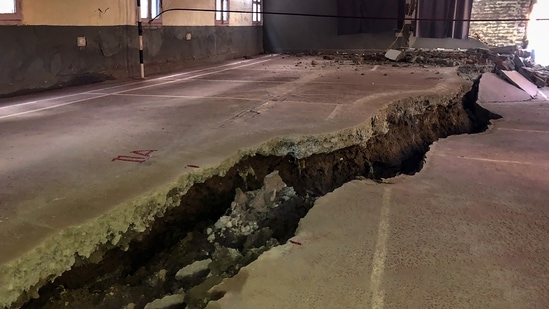Apathy compounds Joshimath’s tragedy
Located on the debris of an ancient landslide, Joshimath is the victim of a refusal to pay heed to warnings from nature, science and people
In May 2010, a short research paper appeared in Current Science, a respected Indian journal. Titled Disaster Looms Large Over Joshimath, the article by two geologists from HNB Garhwal University said a tunnel boring machine excavating the head-race tunnel of National Thermal Power Corporation’s 520 MW Tapovan-Vishnugad hydroelectric project (HEP) punctured an aquifer on December 24, 2009, releasing millions of litres of water daily. They warned of the mishap’s potential for “initiating ground subsidence in the region” and added that its future implications were “sure to be serious.” The portent was brushed aside and forgotten for more than a decade, until December 2022 when the looming threat became a nightmare reality. Hundreds of houses in Joshimath developed cracks in a matter of days, but a cavalier state government failed to respond. Only when thousands of angry residents poured into the streets did the hitherto unmoved administration designate Joshimath as a “sinking zone”. Nearly 700 houses are now uninhabitable, and residents are being hurriedly shifted to relief camps on safer ground.

Joshimath is located on the debris of an ancient landslide, near the seismically sensitive Main Central Thrust (MCT) zone. Over time, the landslide stabilised. In the 8th century AD, Adi Shankaracharya established one of the four pre-eminent Hindu peethas or shrines at Joshimath. The idol of Lord Badrinath resides here during the winter months.
Urban growth began after the 1962 Indo-China border war, with roads built right up to the international border in Chamoli district, and the establishment of an Army cantonment. These activities presaged the first reports of land subsidence incidents.
In 1976, a committee headed by MC Mishra, then commissioner of the Garhwal region, highlighted haphazard construction, deforestation, the use of explosives during road construction, and inadequate drainage of domestic waste waters among the major causes of land subsidence. It recommended a survey to designate stable zones, a ban on tree-felling and heavy construction in the slide zones, and limited construction in the safe areas. More importantly, it recommended that the toe of the hill-slope be protected against scouring by the Alaknanda river. Succeeding administrations largely ignored these recommendations.
In 1993, the Auli slope above Joshimath was reshaped as a ski slope and a 4.5-km-long cable-car ropeway — the second longest in Asia — was constructed. Rapid urbanisation, along with other massive development projects, took off in and around Joshimath after Uttarakhand was granted statehood in 2000. This push included the construction of the Tapovan-Vishnugad HEP around 2005-2006. A Supreme Court-appointed expert body, formed after the 2013 floods disaster, recommended against constructing HEPs in the paraglacial region upstream of the MCT zone. But that advice was again ignored and construction continued apace on HEPs in the Dhauliganga (West) basin, including on the Tapovan-Vishnugad HEP.
In 2020, the High Powered Committee (HPC) for the Char Dham Pariyojana reviewed the Border Roads Organisation’s proposal to build the Helong-Marwari bypass along a hard-rock portion of the Joshimath hill’s toe, arguing that it would reduce traffic congestion in the town and its burden on the sinking area. The townspeople opposed the bypass, fearing its negative impact on their tourism economy, and cited the Mishra Committee recommendation against disturbing the hill’s toe. In a compromise, HPC recommended that Badrinath-bound traffic be routed through the town and the bypass be used for returning traffic. While accepting the bypass proposal, it stipulated that construction be preceded by prior large-scale geological, geophysical and geotechnical testing of the rocks along the toe. Apparently, the stipulation was also ignored.
In February 2021, a major flood in the Rishiganga and the Dhauliganga rivers wrecked sections of the Tapovan-Vishnugad HEP, and sediment-laden waters flooded its head-race tunnel. Around 200 people were declared missing, and assumed to have died in that disaster. Alarmed local residents demanded abandoning the project, but to no avail.
Protests began on November 16, 2021, when cracks started appearing in buildings in one ward of Joshimath. Thereafter, as more buildings got damaged, increasingly worried local people held public protests, alerted the district administration, met state officials, and sent memorandums to the chief minister. By the end of November 2022, in spite of nearly 60 damaged buildings, there was no official action to assess structural damages. Only in late-December, with hundreds of houses affected, did the administration begin its frantic rescue measures.
Twelve years after his paper was published, Piyoosh Rautela’s warnings have come true. The executive director of the Uttarakhand Disaster Mitigation and Management Centre told reporters that the water discharged from a punctured aquifer was the immediate cause of the land sinking. Garhwal commissioner Sushil Kumar confirmed that the situation worsened after the underground water source burst last week.
The local administration’s immediate focus is on shifting homeless families to safe shelters. Decades after the first warnings were sounded, the government has at last initiated surveys and scientific investigations to determine the nature and extent of the calamity, and thereafter initiate slope stabilisation measures.
This must come as cold comfort to the hundreds of grieving families. Fearful, they lie awake at night, anxious about how they will make a living. Those with animals worry where their fodder will come from, those with children about the disruption of their education, those with elderly, sick and disabled family members about health care and basic dignity. All of them agonise about the safety of their possessions left unguarded in their abandoned, crumbling homes. In the frigid cold, they stare helplessly as the dreams those homes represented slip away, along with their furniture, their utensils, their photographs and their memories. All because of an ill-advised assault on a fragile ecosystem, and a dogged refusal to pay heed to warnings from nature, science, and people.
Ravi Chopra is a veteran environmentalist and former head of HPC
The views expressed are personal






